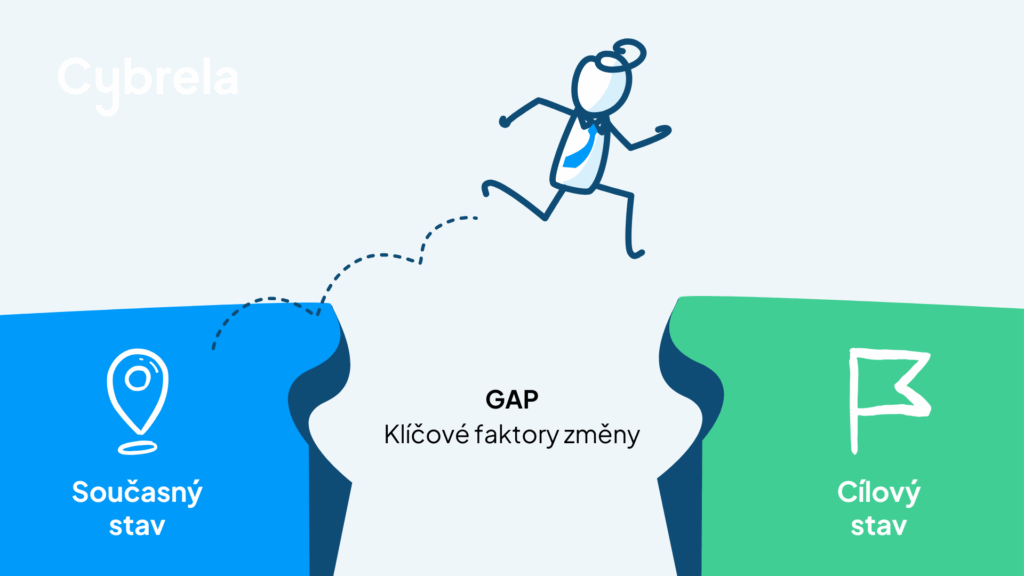- Hana Skoupá
Unsure if your cybersecurity is properly set up? A GAP analysis helps you understand where you stand – what requirements you already meet, what’s missing, and what to do next. It’s the first step toward ensuring you’re neither implementing unnecessary controls nor neglecting critical areas.
What is a GAP analysis and why is it important?
A GAP analysis is a method used to compare your current state with a desired target state – commonly in cybersecurity, compliance, or IT processes. The result is the identification of so-called “gaps,” meaning areas where changes, protections, or improvements are needed. The goal is to gain a clear overview of what’s missing to meet specific objectives or comply with a standard.
A GAP analysis can be narrow (focused on a specific area) or broad (such as a comprehensive review of information security management across the entire organization). It is most commonly used in the following situations:
- before the introduction of new legislation (e.g., the new Cybersecurity Act),
- prior to a certification audit or recertification (ISO 27001, TISAX),
- after significant organizational changes (e.g., acquisition, new ERP system, cloud migration or other changes to IT infrastructure),
- or regularly as a part of cyber risk management.
How does a GAP analysis work?
A well-conducted GAP analysis involves more than checklists and paperwork. It draws from various inputs – interviews with staff, process and control reviews, and the examination of what is (or isn’t) written in internal guidelines. Key steps include:
Mapping the current state
Interviews with key personnel, reviewing documentation, verifying system security, and observing how processes actually function within the organization.
Defining the target
Identifying the standard or benchmark to compare against (e.g., ISO 27001, new legislation, or internal policies) and clarifying what you aim to achieve.
Identifying gaps
By comparing the current state with the desired target, differences are identified – specifically areas where the company does not meet the requirements defined by the chosen framework.
Proposing remedial actions
For each gap, are recommended corrective measures – including who is responsible, deadlines, and required resources.
The output shouldn’t be a complex, jargon-filled report, but a clear and actionable roadmap that even non-technical leadership can follow. A strong deliverable clearly identifies the gaps, their severity, and recommended actions – ideally with estimated timelines and costs.

GAP analysis – practical first step toward compliance with the new Cybersecurity Act
A GAP analysis is an ideal starting point for assessing your current cybersecurity posture against the requirements of the new Cybersecurity Act coming into force in November 2025. If you’ve already implemented some measures (even informally), you’re not starting from scratch. That’s all the more reason to get a clear picture of where you’re compliant, where the gaps are, and what still needs to be fine-tuned. A GAP analysis helps you focus on what really matters – and avoid wasting time on the non-essential.
The same applies to certification preparation – whether ISO 27001 or TISAX. Without a thorough initial assessment, it’s hard to spot potential audit issues or prioritize improvements.
Example
A manufacturing company began preparing for the new Cybersecurity Act in early 2025. While basic technical and organizational measures were already in place, the GAP analysis revealed the following shortcomings:
- Risk management was missing – no documented risks, no continuous evaluation.
- No training plan – staff had only received onboarding security training.
- No incident response procedures – no plan for handling security incidents.
Thanks to the GAP analysis, these issues were clearly defined and addressed through an improvement plan – introducing risk management per ISO 27005 and establishing an annual training program.
What to watch out for?
You can perform a basic comparison on your own. Involving your internal team has the advantage of in-depth knowledge of your environment. However, in practice, we recommend also involving an external expert – someone who brings experience, perspective, and up-to-date knowledge of evolving requirements (such as new laws, attack trends, and industry best practices). If you plan to outsource the GAP analysis, we recommend paying attention to the following:
- Assessment criteria – avoid vague goals like “improve security” – clearly define your benchmark (ISO standard, Cybersecurity Act, internal policy).
- Who’s involved – don’t limit input to the IT department. HR, management, and operations personnel are key, too.
- Final deliverable – The result should be understandable, structured, and actionable. Ideally in a format that feeds directly into your planning process.
Where do gaps typically occur?
Common cybersecurity gaps include:
- Risk management: No systematic approach to identifying and evaluating cyber risks.
- Documentation: Missing or outdated policies and procedures.
- Training: Employees are not regularly trained in cybersecurity best practices.
- Technical measures: Outdated systems, no backups, poor access management.
- Incident management: No defined plan for responding to cyber incidents.
Detect weaknesses early
Whether you're preparing for the Cybersecurity Act, ISO 27001 certification, or simply aiming to improve your organization’s resilience, a well-executed GAP analysis gives you the foundation for informed decisions and effective planning. Don’t wait until it’s too late – find out where your gaps are and address them before attackers do.


